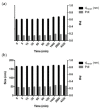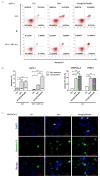Microfluidic-Assisted Preparation of Targeted pH-Responsive Polymeric Micelles Improves Gemcitabine Effectiveness in PDAC: In Vitro Insights
- PMID: 35008170
- PMCID: PMC8750671
- DOI: 10.3390/cancers14010005
Microfluidic-Assisted Preparation of Targeted pH-Responsive Polymeric Micelles Improves Gemcitabine Effectiveness in PDAC: In Vitro Insights
Abstract
Pancreatic ductal adenocarcinoma (PDAC) represents a great challenge to the successful delivery of the anticancer drugs. The intrinsic characteristics of the PDAC microenvironment and drugs resistance make it suitable for therapeutic approaches with stimulus-responsive drug delivery systems (DDSs), such as pH, within the tumor microenvironment (TME). Moreover, the high expression of uPAR in PDAC can be exploited for a drug receptor-mediated active targeting strategy. Here, a pH-responsive and uPAR-targeted Gemcitabine (Gem) DDS, consisting of polymeric micelles (Gem@TpHResMic), was formulated by microfluidic technique to obtain a preparation characterized by a narrow size distribution, good colloidal stability, and high drug-encapsulation efficiency (EE%). The Gem@TpHResMic was able to perform a controlled Gem release in an acidic environment and to selectively target uPAR-expressing tumor cells. The Gem@TpHResMic displayed relevant cellular internalization and greater antitumor properties than free Gem in 2D and 3D models of pancreatic cancer, by generating massive damage to DNA, in terms of H2AX phosphorylation and apoptosis induction. Further investigation into the physiological model of PDAC, obtained by a co-culture of tumor spheroids and cancer-associated fibroblast (CAF), highlighted that the micellar system enhanced the antitumor potential of Gem, and was demonstrated to overcome the TME-dependent drug resistance. In vivo investigation is warranted to consider this new DDS as a new approach to overcome drug resistance in PDAC.
Keywords: active drug targeting; controlled release; drug delivery; drug resistance; pH-responsiveness; pancreatic ductal adenocarcinoma; tumor microenvironment; uPAR.
Conflict of interest statement
The authors declare no conflict of interest.
Figures















Similar articles
-
Tumor microenvironment and metabolic remodeling in gemcitabine-based chemoresistance of pancreatic cancer.Cancer Lett. 2021 Nov 28;521:98-108. doi: 10.1016/j.canlet.2021.08.029. Epub 2021 Aug 27. Cancer Lett. 2021. PMID: 34461181
-
Dual drug-loaded tumor-targeted polymeric nanoparticles for enhancing therapeutic response in pancreatic ductal adenocarcinoma.Mater Today Bio. 2024 Aug 10;28:101199. doi: 10.1016/j.mtbio.2024.101199. eCollection 2024 Oct. Mater Today Bio. 2024. PMID: 39205875 Free PMC article.
-
Aronia Berry Extract Modulates MYD88/NF-kB/P-Glycoprotein Axis to Overcome Gemcitabine Resistance in Pancreatic Cancer.Pharmaceuticals (Basel). 2024 Jul 9;17(7):911. doi: 10.3390/ph17070911. Pharmaceuticals (Basel). 2024. PMID: 39065761 Free PMC article.
-
Tumor Microenvironment-Responsive Drug Delivery Based on Polymeric Micelles for Precision Cancer Therapy: Strategies and Prospects.Biomedicines. 2024 Feb 11;12(2):417. doi: 10.3390/biomedicines12020417. Biomedicines. 2024. PMID: 38398021 Free PMC article. Review.
-
Gemcitabine-Based Neoadjuvant Treatment in Borderline Resectable Pancreatic Ductal Adenocarcinoma: A Meta-Analysis of Individual Patient Data.Front Oncol. 2020 Aug 11;10:1112. doi: 10.3389/fonc.2020.01112. eCollection 2020. Front Oncol. 2020. PMID: 32850319 Free PMC article.
Cited by
-
Combining 3D Printing and Microfluidic Techniques: A Powerful Synergy for Nanomedicine.Pharmaceuticals (Basel). 2023 Jan 1;16(1):69. doi: 10.3390/ph16010069. Pharmaceuticals (Basel). 2023. PMID: 36678566 Free PMC article. Review.
-
Recent Advances in Nanodrug Delivery Systems Production, Efficacy, Safety, and Toxicity.Methods Mol Biol. 2025;2834:303-332. doi: 10.1007/978-1-0716-4003-6_15. Methods Mol Biol. 2025. PMID: 39312172 Review.
-
Cervical cancer benefits from trabectedin combination with the β-blocker propranolol: in vitro and ex vivo evaluations in patient-derived organoids.Front Cell Dev Biol. 2023 Jun 13;11:1178316. doi: 10.3389/fcell.2023.1178316. eCollection 2023. Front Cell Dev Biol. 2023. PMID: 37384250 Free PMC article.
-
For and against tumor microenvironment: Nanoparticle-based strategies for active cancer therapy.Mater Today Bio. 2025 Mar 1;31:101626. doi: 10.1016/j.mtbio.2025.101626. eCollection 2025 Apr. Mater Today Bio. 2025. PMID: 40124335 Free PMC article. Review.
-
Microfluidic Devices: A Tool for Nanoparticle Synthesis and Performance Evaluation.ACS Nano. 2023 Aug 8;17(15):14205-14228. doi: 10.1021/acsnano.3c01117. Epub 2023 Jul 27. ACS Nano. 2023. PMID: 37498731 Free PMC article. Review.
References
-
- AIOM. [(accessed on 15 September 2021)]. Available online: https://www.aiom.it/wp-content/uploads/2020/10/2020_LG_AIOM_Pancreas.pdf.
-
- Porcelli L., Iacobazzi R.M., Di Fonte R., Serratì S., Intini A., Solimando A.G., Brunetti O., Calabrese A., Leonetti F., Azzariti A., et al. CAFs and TGF-β Signaling Activation by Mast Cells Contribute to Resistance to Gemcitabine/Nabpaclitaxel in Pancreatic Cancer. Cancers. 2019;11:330. doi: 10.3390/cancers11030330. - DOI - PMC - PubMed
Grants and funding
LinkOut - more resources
Full Text Sources
Research Materials

